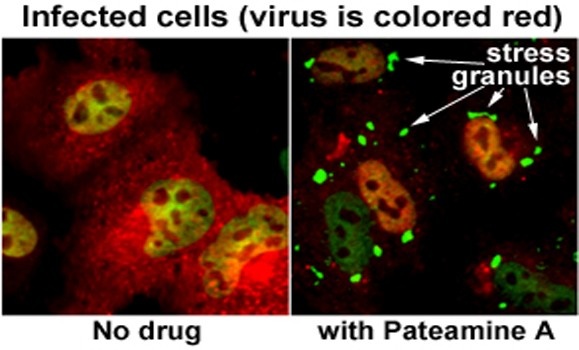News
» Go to news mainFinding new weapons to fight flu

Dalhousie Medical School researchers have discovered a potential new treatment for influenza A – the virus responsible for flu pandemics.
By studying the way the virus interacts with infected cells, Drs. Craig McCormick and Denys Khaperskyy found that pateamine A, a natural product derived from the New Zealand marine sponge, was able to effectively block influenza virus infection.
“Over time, circulating influenza strains mutate and develop resistance to both Tamiflu and amantadine – two antivirals used clinically against influenza,” says Dr. Khaperskyy, research associate in the Department of Microbiology & Immunology. “Viruses evolve rapidly and in the absence of a universal flu vaccine, the research into new antivirals capable of blocking influenza becomes very important.”
“Treatment of influenza-infected cells with pateamine A stopped the infection in its tracks.”
Natural immunity
Through previous infection or vaccination, our immune systems recognize influenza viruses and limit their ability to cause a full-blown infection. But because flu viruses change every year, our immune systems are constantly being challenged to identify new strains.
In addition, our bodies have a first line of defense against infection; it’s known as innate immunity. Drs. Khaperskyy and McCormick are studying our innate defenses against viruses. They found that one of the mechanisms of antiviral defense involves the creation of structures inside our cells that trap viruses and prevent them from multiplying. These traps are called stress granules, and influenza is very good at preventing these stress granule traps from forming.
“Influenza viruses are so successful because they are good at undermining our immune defenses. We need new ways to bolster these defenses,” says Dr. Craig McCormick, associate professor in the Department of Microbiology and Microbiology.
Potential new antiviral
Influenza viruses have very small genomes that only encode twelve proteins, but these proteins are remarkably efficient at undermining host defenses and turning infected cells into factories for the production of new viruses.
Drs. Khaperskyy and McCormick found that three of these twelve viral proteins can block formation of antiviral stress granules. When any of these three viral proteins were disabled, they observed that the influenza virus could no longer stop stress granules from forming; the cell was able to trap the virus and keep the infection from progressing.
“The dedication of so much of the viral genome to control of stress granules suggests that they normally play a very important role in antagonizing viral infection. This opens up a possibility that stress-granule inducing drugs like pateamine A may be used as effective antivirals,” explains Dr. McCormick.
“To thrive, viruses are absolutely dependent on host cells. And Pateamine A creates an inhospitable environment for the virus inside these host cells.”
Yearly influenza epidemics can seriously affect all populations – especially young children and those over 65. Annual flu epidemics result in up to five million cases of severe illness and 500,000 deaths worldwide.
Recent News
- Dalhousie’s first physician assistant cohort steps into Nova Scotia’s healthcare system
- Dalhousie med students explore pediatric care in Austria
- Dalhousie researchers shine at Discovery Awards with four top honours
- New $2M national study to uncover how biology, social factors shape MS outcomes
- Pathology EDIA Committee makes strides during 2024‑2025 year
- CCfV’s impact on vaccine innovation
- Unlocking the secrets of memory—with fruit flies
- Celebrating mobility research and the power of philanthropy
